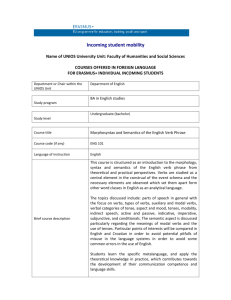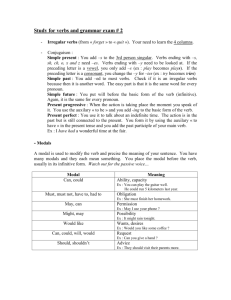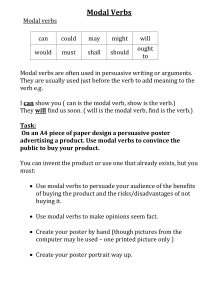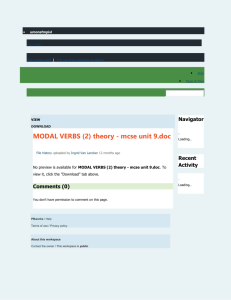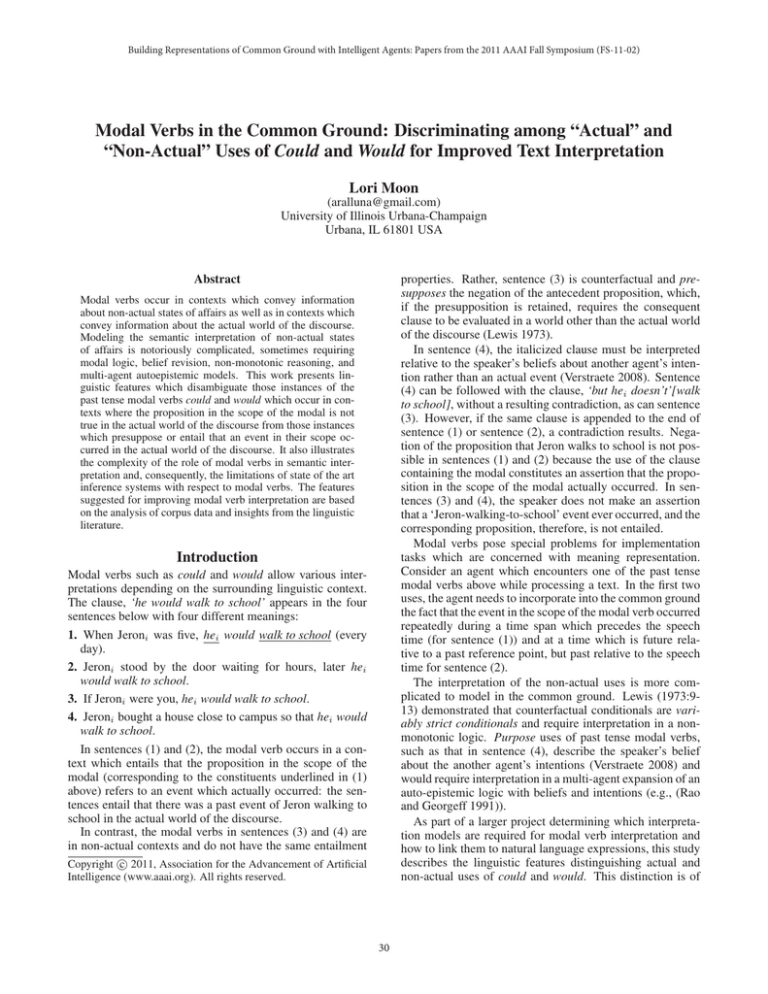
Building Representations of Common Ground with Intelligent Agents: Papers from the 2011 AAAI Fall Symposium (FS-11-02)
Modal Verbs in the Common Ground: Discriminating among “Actual” and
“Non-Actual” Uses of Could and Would for Improved Text Interpretation
Lori Moon
(aralluna@gmail.com)
University of Illinois Urbana-Champaign
Urbana, IL 61801 USA
properties. Rather, sentence (3) is counterfactual and presupposes the negation of the antecedent proposition, which,
if the presupposition is retained, requires the consequent
clause to be evaluated in a world other than the actual world
of the discourse (Lewis 1973).
In sentence (4), the italicized clause must be interpreted
relative to the speaker’s beliefs about another agent’s intention rather than an actual event (Verstraete 2008). Sentence
(4) can be followed with the clause, ‘but hei doesn’t’[walk
to school], without a resulting contradiction, as can sentence
(3). However, if the same clause is appended to the end of
sentence (1) or sentence (2), a contradiction results. Negation of the proposition that Jeron walks to school is not possible in sentences (1) and (2) because the use of the clause
containing the modal constitutes an assertion that the proposition in the scope of the modal actually occurred. In sentences (3) and (4), the speaker does not make an assertion
that a ‘Jeron-walking-to-school’ event ever occurred, and the
corresponding proposition, therefore, is not entailed.
Modal verbs pose special problems for implementation
tasks which are concerned with meaning representation.
Consider an agent which encounters one of the past tense
modal verbs above while processing a text. In the first two
uses, the agent needs to incorporate into the common ground
the fact that the event in the scope of the modal verb occurred
repeatedly during a time span which precedes the speech
time (for sentence (1)) and at a time which is future relative to a past reference point, but past relative to the speech
time for sentence (2).
The interpretation of the non-actual uses is more complicated to model in the common ground. Lewis (1973:913) demonstrated that counterfactual conditionals are variably strict conditionals and require interpretation in a nonmonotonic logic. Purpose uses of past tense modal verbs,
such as that in sentence (4), describe the speaker’s belief
about the another agent’s intentions (Verstraete 2008) and
would require interpretation in a multi-agent expansion of an
auto-epistemic logic with beliefs and intentions (e.g., (Rao
and Georgeff 1991)).
As part of a larger project determining which interpretation models are required for modal verb interpretation and
how to link them to natural language expressions, this study
describes the linguistic features distinguishing actual and
non-actual uses of could and would. This distinction is of
Abstract
Modal verbs occur in contexts which convey information
about non-actual states of affairs as well as in contexts which
convey information about the actual world of the discourse.
Modeling the semantic interpretation of non-actual states
of affairs is notoriously complicated, sometimes requiring
modal logic, belief revision, non-monotonic reasoning, and
multi-agent autoepistemic models. This work presents linguistic features which disambiguate those instances of the
past tense modal verbs could and would which occur in contexts where the proposition in the scope of the modal is not
true in the actual world of the discourse from those instances
which presuppose or entail that an event in their scope occurred in the actual world of the discourse. It also illustrates
the complexity of the role of modal verbs in semantic interpretation and, consequently, the limitations of state of the art
inference systems with respect to modal verbs. The features
suggested for improving modal verb interpretation are based
on the analysis of corpus data and insights from the linguistic
literature.
Introduction
Modal verbs such as could and would allow various interpretations depending on the surrounding linguistic context.
The clause, ‘he would walk to school’ appears in the four
sentences below with four different meanings:
1. When Jeroni was five, hei would walk to school (every
day).
2. Jeroni stood by the door waiting for hours, later hei
would walk to school.
3. If Jeroni were you, hei would walk to school.
4. Jeroni bought a house close to campus so that hei would
walk to school.
In sentences (1) and (2), the modal verb occurs in a context which entails that the proposition in the scope of the
modal (corresponding to the constituents underlined in (1)
above) refers to an event which actually occurred: the sentences entail that there was a past event of Jeron walking to
school in the actual world of the discourse.
In contrast, the modal verbs in sentences (3) and (4) are
in non-actual contexts and do not have the same entailment
c 2011, Association for the Advancement of Artificial
Copyright Intelligence (www.aaai.org). All rights reserved.
30
Terms and Approach
special importance for systems which want to determine
which actions some agent actually performed or avoid deriving real world entailments from non-actual contexts (e.g.,
the PASCAL RTE Challenge), for Natural Language Inference systems (see Schubert et. al 2010 for the presentation
of such a system and for a recent concise summary of previous work), as well as for tasks extracting facts from report documents or encyclopedic sources in order to build a
general-purpose knowledge base.
Some non-actual uses of modal verbs have been associated with linguistic expressions such as clauses with irrealis
mood or non-veridical operators (Giannakidou 2009) (for a
concise summary of the complexity of these mappings, see
Marques (2009:182-190)). The non-actual contexts here refer more broadly to contexts in which the proposition in the
scope of the modal has some morphological marking indicating that it describes non-actual information (e.g., the
presence of tense marking indicating the subjunctive mood
in English) or which, due to some clausal or extra-clausal
information, describes a non-actual state of affairs.
The notion of actual refers to uses of sentences corresponding to propositions which are either presupposed or
entailed to be true in the actual world of the discourse.
These propositions are assumed to enter the agent’s common
ground as facts about the world of the discourse. Non-actual
uses are a much broader class and include sentences corresponding to propositions which are only true relative to a
participant’s belief model, for example, or only true relative
to a non-actual possible world. These propositions do not
enter the common ground as facts about the actual world of
the discourse, but there are fairly reliable presuppositions or
inferences associated with them which do provide information about the actual world.
The actual/non-actual distinction differs from
(non)veridicality as follows: An operator (e.g., a modal
verb, a propositional attitude verb) is considered to be
veridical if the proposition in its scope is presupposed
or entailed to be true in at least one belief world of the
speaker’s (or subject’s) epistemic model (Giannakidou
(2009:1889)). Therefore (non)veridicality is a cross-cutting
notion with respect to (non)actuality in that it includes
propositional attitude verbs which enter the shared common
ground as beliefs about another’s beliefs or, more generally,
beliefs about a proposition under the category ‘veridical’,
making it not equivalent to our notion of ‘actual’.
Modal verbs have traditionally been claimed to have a single meaning which takes two arguments: a proposition and
a context (Kratzer 1977). The proposition corresponds to
the sentence in which the modal occurs (underlined in (5)
below), and the context refers to accessible worlds and an
ordering relation on the accessible worlds (Kratzer 1981).
Project Design and Goals
The primary goal of this work is to determine what linguistic expressions co-occur with the past tense modal verbs
in actual versus non-actual contexts. Generally, theoretical linguistic studies work with sets of linguistic expressions or morphological markings in order to determine what
meanings they systematically express. The approach in this
project differs slightly, in that it first classifies naturally occurring data with respect to its entailment properties, and
second looks for evidence of the expected linguistic patterns
as well as phenomena which have previously gone unnoticed.
Linguistic descriptions of the entailment patterns of
modal verbs (see (Portner 2009) for references) and their
association with cross-linguistic patterns has been an active
area of investigation in the linguistics literature (e.g., (Iatridou 2000), (Giannakidou 2009), (von Stechow and Grønn
2008), and others). There has not, however, been a link
made between this theoretical research and the practical task
of mapping the generalizations to features which can be
straightforwardly encoded in broad-coverage tasks. The gap
is largely due to the complexity and variety of interpretations modal verbs require, and the high-level nature of the
relevant linguistic features.
Previous implementations which attempted to characterize whether modal verbs were (non)actual overgeneralized
by associating lexical modal verbs uniformly with an entailment pattern (e.g., MacCartney et. al 2006, MacCartney(2009:57)). The importance of expressions which signal
non-actual contexts continues to be recognized in the textual
entailment community, but the work has focused more on
categories which can be associated with non-functional lexical expressions. For example, recent work has been done
on Negative Polarity Items and downward entailing expressions (Danescu-Niculescu-Mizil and Lee 2010), and on embedding verbs (non-factive, implicative, etc.) and their relations to presuppositions (e.g., (Clausen and Manning 2009)).
Modal verbs, however, constitute a significant portion of
non-actual contexts in open domain corpora and interact
with other expressions signaling (non)actual contexts.
Past tense modal verbs are also under-represented in test
sets for state of the art tools, for example, the FraCas set
(Cooper et al. 1996) contains only two examples with would
and none with could, making the performance of systems
with respect to modal interpretation difficult to measure. As
inference systems improve, a more thorough understanding
of the various interpretations of modal verbs is required for
accurate broad-coverage performance.
5. He could do more to help.
The seeming ambiguities, such as that between epistemic
and deontic readings, are said to arise from a difference in
accessible worlds and ordering relations.
Non-actual states of affairs relative to which past tense
modal verbs are sometimes evaluated can be expressed by
an antecedent proposition or by some other linguistic means.
The non-actual state of affairs can also be contextually specified. In the descriptions that follow, the term ‘non-actual
state of affairs’ includes all means of specifying the restriction on the clause containing the past tense modal, unless the
description mentions linguistic properties of the antecedent
clause or the embedding verb.
The letter φ and γ will be used as abbreviations for propositions in the discussion which follows.
31
Data and Classification
anchor at the sentence level. Because this ambiguity is likely
to be resolved at the discourse level, it was considered beyond the scope of the current project and the two forms were
put into a single category. Non-past counterfactual uses of
could enter the common ground as information regarding a
non-actual state of affairs which, in general, does not hold
at speech time, allowing the actual world inference that the
proposition in the scope of the modal does not hold.
Past counterfactual uses of could are well-known to exhibit ‘sequence of tense’ phenomena (Abusch 1997) (Portner (2009:223-230)) when embedded under a past tense
verb. In these cases, the past tense marking associated with
the modal verb could can either refer to an event located at
the same temporal point as the embedding verb or at a time
following. Because a significant number of the past counterfactual uses occurred as the complement of a verb, the
ambiguity was frequently exhibited in the data. Because either reading is past relative to the speech time, they were
merged into the category of past counterfactuals. Past counterfactuals enter the common ground as information about
a state of affairs which (in general) did not hold at a time
preceding the speech time. In these cases could (φ), where
the sentence corresponding to φ contains a past tense verb,
holds relative to a past non-actual state of affairs and, it is
inferred that φ did not hold in the actual world at that time.
Past perfect counterfactuals were put into their own class
in order to keep some parallel between the would and could
non-actual uses and because they never show ambiguity with
actual uses. This distinction is more semantically motivated
with would than could, as some examples of could without
the past perfect marker have share a temporal structure with
past perfect uses.
The 48 actual instances with would seemed to form three
major groups. The habitual in the past uses involve reference to an event which occurred repeatedly in the past. In
uses with habitual past tense, would(φ) updates the common
ground with the information that φ occurred repeatedly at
some time span which precedes the speech time. The future
in the past uses refer to an event which occurred after the
reference time but before the speech time. In the case of future in the past uses, would(φ) updates the common ground
with information that φ occurred in the future relative to the
reference time but preceding the speech time.
A third category of uses which naturally emerged are
here labeled ‘dispositional-indicative’, for lack of a better
mnemonic. They include not only examples that would be
considered dispositional (e.g., What man wants, they would
do anything to get it. (C1 27)), but also examples which
correspond to similar instances labeled gnomic or habitual
future (An SUV would get good gas mileage sitting in the
drive. (C1 239)) in other taxonomies (e.g.,(Giomi 2010)).
While these examples do not exhibit the same clear-cut entailment properties of the genuine past uses, they have a
habitual flavor which makes them seem to support at least
a valid common-sense inference that the event has held at
some time point or currently holds, that is, that an SUV does
get (or has gotten) good gas mileage sitting in the drive and
men do indeed do anything (or have done anything) to get
what they want (if the speaker’s authority to say this can be
In this project, sentences containing could and would were
extracted from an 80,000 line corpus of weblog texts. Each
instance of could or would was indexed and hand-classified
according to whether the instance was actual or non-actual,
then according to its entailment class as shown in the table
below:
modal
could
would
(non)actual
actual
non-actual
actual
non-actual
entailment class
non-past counterfactual
past counterfactual
past perfect counterfactual
habitual in the past
future in the past
‘dispositional-indicatives’
hypothetical
non-past counterfactual
past perfect counterfactual
The three columns in the table above, modal, (non)actual,
and entailment class will be referred to as ‘levels of classification’. The amount of data classified were approximately
10% of the instances of could and would extracted from the
corpus, in anticipation of using cross-fold validation when
automatically classifying the remaining instances with semisupervised machine learning methods.
This section describes the semantic entailments and presuppositions which enter the common ground and how they
are associated with the proposed entailment classes. The
following section discusses the probabilistic correlation between the entailments and easily-identifiable syntactic features.
All actual uses of could were put into one group, partly
due to the small sample size (28 instances). The following distinctions, however, were relevant: (i) uses with a reference time to a past possibility which was realized either
simultaneously (with respect to reference time) or subsequently (but before the speech time). In this case, could(φ)
entails that the proposition φ enters the common ground
at the reference time but preceding speech time. (ii) uses
which describe a past impossibility being removed at the
reference time. In these uses, could(φ) entails φ and the
presupposition holds that ¬ φ held before the reference
time. Instances in the data imply that φ occurred, therefore, they were classified with actual uses. And (iii), uses
which are in the scope of a veridical verb (e.g., a verb of
perception). Often, ‘A could (see//hear//discern) X’ entails
‘A (saw/heard/discerned) X’.
The 85 non-actual instances of could were divided into
three categories. Non-past counterfactuals, past counterfactuals, and past perfect counterfactuals.
Non-past counterfactuals included present counterfactual
and hypothetical instances. Following Iatridou (2000), it
holds in the data that the distinction between the hypothetical (or Future Less Vivid) and present counterfactual uses is
disambiguated by the Aktionsart of the antecedent predicate,
however, many instances of non-past could uses were not in
conditional constructions, and, therefore, lacked a temporal
32
trusted). They have a similarity to indicative conditionals in
that, whenever the condition is met (e.g., the SUV is in the
drive), the proposition in the scope of would holds. These
forms might be treated as holding whenever the restrictor
holds, regardless of the temporal reference point relative to
speech time.
Among the non-actual uses of would, three categories
were identified roughly similar to those for could: hypotheticals, non-past counterfactuals, and past perfect counterfactuals. In the case of would, the hypothetical and present
tense counterfactuals were separated into their own categories. The main reason for this separation is that non-actual
uses of would were most frequently expressed in the form of
a conditional. Therefore, it was possible to disambiguate
hypotheticals and present tense counterfactuals based on the
Aktionsart of the antecedent verb. Unlike could, all of the
past tense counterfactuals include the past perfect auxiliary
have; therefore, there was no motivation to have a past label as well. None of the past uses were ambiguous with
actual uses. For hypothetical uses of would, the proposition
in the scope of would enters the common ground relative to
a condition which is future with respect to speech time. In
present counterfactual uses, the condition does not hold at
speech time.
Past counterfactuals have a proposition in the scope of
would which enters the common ground relative to a past
condition which did not hold, as with could.
Figure 1: The distribution of ‘actual’ uses of could (gray) and
would (black).
At the classification level of the (non)actual distinction,
no actual instances with either modal verb occurred in the
consequent of a conditional.1 Although such uses are attested in the linguistic literature (Crouch 1993:176), they did
not occur in the sample, indicating that they are not frequent.
Two highly probable rules, then, are:
Rule i: If a clause contains a past tense modal verb
(could or would), some form of the past perfect marker
have, and a verb in the past perfect tense, the proposition in the scope of the modal is non-actual.
Rule ii: Given a conditional sentence with a past tense
modal (could or would) in the consequent clause, the
use is non-actual.
Correlation between Semantic Categories and
Syntactic Features
Rules (i) and (ii) account for the classification of 40.9% of
the total data.
Within this distinction, each example contained the temporal sequence in which the antecedent preceded the consequent, that is, there were no instances of backtracking
(Lewis 1979). The reason for the lack of backtracking was
that the Aktionsart of the predicates in the sample was such
that the antecedent preceding the consequent was the order predicted by standard theories. So we can also add the
highly probable temporal rule to the common ground that,
given a conditional sentence with the antecedent γ and consequent φ, the reference time of γ ≤ the reference time of φ
in the world(s) of evaluation.
With respect to other syntactic categories, there was variation between the could and would examples: For actual
uses of would, 54% occurred in free-standing form, 27%
as the complement of verbs with relative clause and other
uses comprising 10% and 8% respectively, as shown in Figure 1. In contrast, actual uses with could were fairly evenly
distributed over all non-conditional construction types in the
20%-30% range.
For the non-actual uses, conditionals were much more
common for would uses, comprising 43% of the instances.
Within each semantic category, the data was organized according to sentence-level features which helped distinguish
the uses. The first division was according to syntactic structure. Each final category of the semantic classification was
sorted according to the following syntactic division:
Conditional (Cond): instances in the consequent clause of
a conditional sentence
Free-Standing (FS): instances in a main clause, possibly
with adjuncts or coordination
Relative Clause (RC): instances in a clause headed by a
noun phrase
Complement Clause (CC): instances in a clause which is
the complement of a verb
Other (OT): instances in adjunct or coordinating constructions which seemed to exhibit exceptional properties
Syntactic constructions were chosen as a level of classification after the semantic categories were formed because the
data exhibited some systematic use of constructions and because correlations between syntactic construction and meaning can be encoded relatively easily. Using syntactic properties as a feature correlated with meaning can make improved interpretation easier to achieve and reduce the need
for hand annotation (cf. Fernandez et. al 2007). Correlations
between syntactic category and semantic classification were
measured at the modal verb level, the (non)actual level, and
the more detailed entailment class level of the classification.
1
Instances with even if in the antecedent or still in the consequent were difficult to classify. Of the ten examples present in the
corpus, five seemed arguably actual, however, since the antecedent
is hypothetical, the semantics would still require evaluation of the
conditional relative to a non-actual world.
33
Figure 2: The distribution of ‘non-actual’ uses of could (gray) and
Figure 3: Given an actual occurrence of the modal could (black)
would (black).
or a non-actual occurrence (gray), this chart shows the likelihood
that a particular construction will be used.
Free-standing uses were 32%, making free-standing instances of would highly ambiguous without finer-grained
analysis. As a working hypothesis for feature design, freestanding actual uses of would typically occur in narrative sequences, where the surrounding clauses are in the past tense
or as the complement of a verb which is generally considered
to be veridical. Relative clauses and complement clauses
were a more common strategy for encoding actual uses than
non-actual.
Non-actual uses of could were much more rare in conditionals (only 11%), with free-standing uses at 33%, comparable with would. Relative clause and complement clause,
uses, however, were much more prevalent than with would,
as shown in Figure 2.
Looking at the question of by what linguistic methods
actual versus non-actual uses are encoded, it is clear that
construction-type plays a much more prominent role in disambiguation with would than with could. Also, propositional attitude verbs and ‘verbs of saying or telling’ (Levin
1993) form an ambiguous class in naturally occurring data,
being present as heads of complement clauses in both actual
and non-actual instances.
Of the complement clause examples of both modal types
with very strong entailments, 80% of actual and 20% of nonactual uses were headed by verbs of speaking, telling, or
transfer of message (Levin 1993), and 40% actual and nonactual examples of both were headed by verbs of ‘declaring’
or ‘conjecturing’(note that a verb can belong to more than
one Levin class).
Some verbs were expected to be heads of non-actual complement clauses (e.g., wish, deny, wager, predict, think)
and actual complement clauses (e.g., know, be glad, understand). But other verbs crossed categories, including admit,
and said.
In current work, we are testing when human subjects infer the proposition in the scope of could given the embedding verb’s class and the presence of temporal or descriptive
adverbs in the complement clause. Similar testing will be
conducted in order to isolate the role of additional syntactic
features within the constructions examined in this work.
At the more fine-grained entailment class level, we found
that future in the past uses of would were usually encoded
as complement clauses and that past counterfactual could
was usually in conditional form. For reasons previously
mentioned, present counterfactual and hypothetical uses of
would were usually in conditional form, however, hypothetical uses were more frequently in free-standing constructions
than present counterfactuals, indicating that, in the absence
of antecedent cues, uses of would are often taken to be hypothetical. For non-actual uses of could, the choice of relative
clauses for encoding was prevalent for all entailment classes.
Summary
In conclusion, two easily encoded rules were given which
account for the (non)actual classification of 40.9% of the
data. For the remaining 60% of the data, the following features are relevant: (i) For complement clauses, inventories
of verb classes for the embedding verb (e.g., (Karttunen
1973)), and their (non)veridical properties play an important role. (ii) For free-standing uses, important features are
sequences of modal verbs or past tense verbs in coordinated
clauses and the presence of temporal adverbs (iii) For relative clauses, the nature of the antecedent matters: If it is
non-actual, so is the proposition in the relative clause. The
type of verb in the scope of the modal also plays a role in
the (non)actual distinction. (iv) In other uses, the type of coordinating conjunction is important (e.g., modal verbs following so that were always non-actual, but following so, in
contrast, were either). Suggestions for finer-grained classification were also suggested.
By proposing an entailment-based taxonomy then correlating it with easily encoded syntactic features, the study
makes two significant innovations: First, it elucidates the
entailments, presuppositions, and inferences which are systematically associated with various uses of past tense modal
verbs. Second, it renders the problem of associating a meaning with natural language data tractable by uncovering the
correlations between entailment classes and syntactic features which are easily identified by state of the art tools such
as syntactic parsers or lexical ontologies.
Future Work
Because this corpus was built from weblogs which were returned by search results with could and would, there is a
possibility that the sample is biased towards documents with
34
Danescu-Niculescu-Mizil, C., and Lee, L. 2010. Don’t
‘have a clue’? Unsupervised co-learning of downwardentailing operators. In Proceedings of the ACL Short Papers,
247–252.
Fernandez, R.; Ginzburg, J.; and Lappin, S. 2007. Classifying non-sentential utterances in dialogue: a machine learning approach. Computational Linguistics 33(3):397–427.
Giannakidou, A. 2009. the dependency of the subjunctive revisited: Temporal semantics and polarity. Lingua
119:1883–1908.
Giomi, R. 2010. Para uma caracterização semântica do futuro sintético românico: descrição e análise dos valores do
futuro do indicativo em Português e em Italiano. Master’s
thesis, Universidade de Lisboa Faculdade de Letras.
Iatridou, S. 2000. The grammatical ingredients of counterfactuality. Linguistic Inquiry 31(2):231–270.
Karttunen, L. 1973. Presuppositions of compound sentences. Linguistic Inquiry 4(2):169–193.
Kratzer, A. 1977. What ‘must’ and ‘can’ must and can mean.
Linguistics & Philosophy 1:337–355.
Kratzer, A. 1981. Words, Worlds and Contexts. Berlin: de
Gruyter. chapter The Notional Category of Modality.
Levin, B. 1993. English Verb Classes and Alternations.
University of Chicago Press.
Lewis, D. 1973. Counterfactuals. Blackwell Publishers.
Lewis, D. 1979. Counterfactual dependence and time’s arrow. Nous 13:455–476. Reprinted in Lewis (1986) Philosophical Papers (Vol. 2). Oxford: Oxford University Press.
MacCartney, B.; Grenager, T.; de Marneffe, M.-C.; Cer, D.;
and Manning, C. D. 2006. Learning to recognize features of
valid textual entailments. In Proceedings of the Human Language Technology Conference of the North American Chapter of the Association for Computational Linguistcs (HLTNAACL 2006, 41–48.
MacCartney, B. 2009. Natural Language Inference. Ph.D.
Dissertation, Stanford University.
Marques, R. 2009. Cross-linguistic Semantics of Tense, Aspect, and Modality. John Benjamins Publishing Company.
chapter On the selection of mood in complement clauses,
179–204.
Portner, P. 2009. Modality. Oxford Surveys in Semantics
and Pragmatics. Oxford University Press.
Rao, A. S., and Georgeff, M. P. 1991. Modeling rational
agents within a BDI-architecture.
Schubert, L. K.; Durme, B. V.; and Bazrafshan, M. 2010.
Entailment inference in a natural logic-like general reasoner.
In AAAI 2010 Fall Symposium Series, volume (CSK-10).
Verstraete, J.-C. 2008. The status of purpose, reason, and
intended endpoint in the typology of complex sentences: implications for layered models of clause structure. Linguistics
46(4):757–788.
von Stechow, A., and Grønn, A. 2008. Tense and presupposition in counterfactuals. Handout from a talk at New York
University.
Figure 4: Given an actual occurrence of the modal would (black)
or a non-actual occurrence (gray), this chart shows the likelihood
that a particular construction will be used.
a high frequency of modal verbs: there were approximately
four times as many non-actual instances of would as actual
and approximately three times as many non-actual instances
of could as actual. Such documents would, more likely, contain sequences of modal verbs in a description of non-actual
events, which is what we found looking at the full weblog
texts. For this reason, future work is being done using the
English Gigaword Corpus (4th ed.) and will proceed by extracting instances of past tense modal verbs from that corpus. Furthermore, the two past tense English modal verbs,
might and should will be added to the target data, making
the set of English past tense modal verbs covered complete.
For cases which were hard to classify, similar examples
are being constructed for an experimental study with human
subjects to see what inferences are associated with variations in syntactic form and verb classes. A formal theoretical
model of the entailment classes is also being further developed for implementation in a logical model.
Acknowledgements
This work benefited from the support of my adviser, Peter
Lasersohn, and committee members Tania Ionin, Shalom
Lappin, and Jose Meseguer as well as comments from the
audience at TMEI 2011 on slides over this topic. All errors
are my own.
References
Abusch, D. 1997. Sequence of tense and temporal de re.
Linguistics and Philosophy 20(1):1–50.
Clausen, D., and Manning, C. D. 2009. Presupposed content and entailments in natural language inference. In Proceedings of the 2009 Workshop on Applied Texual Inference,
ACL-IJCNLP 2009, 70–73. ACL and AFNLP.
Cooper, R.; Crouch, D.; van Eijck, J.; Fox, C.; van Genabith,
J.; Jaspars, J.; Kamp, H.; Milward, D.; Pinkal, M.; Poesio,
M.; and Pulman, S. 1996. Using the framework. The FraCaS
Consortium.
Crouch, R. 1993. The Temporal Properties of English
Conditionals and Modals. Ph.D. Dissertation, University of
Cambridge.
35




